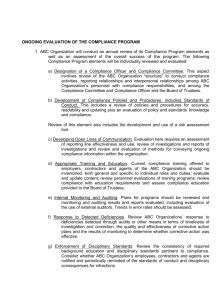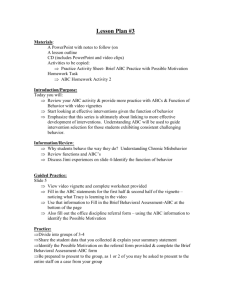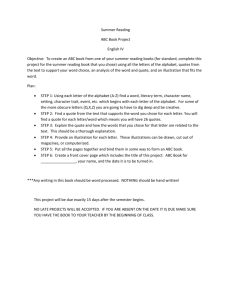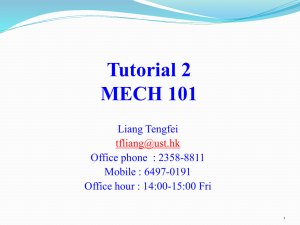ABC Lesson - Arlee Joint School District No. 8
advertisement
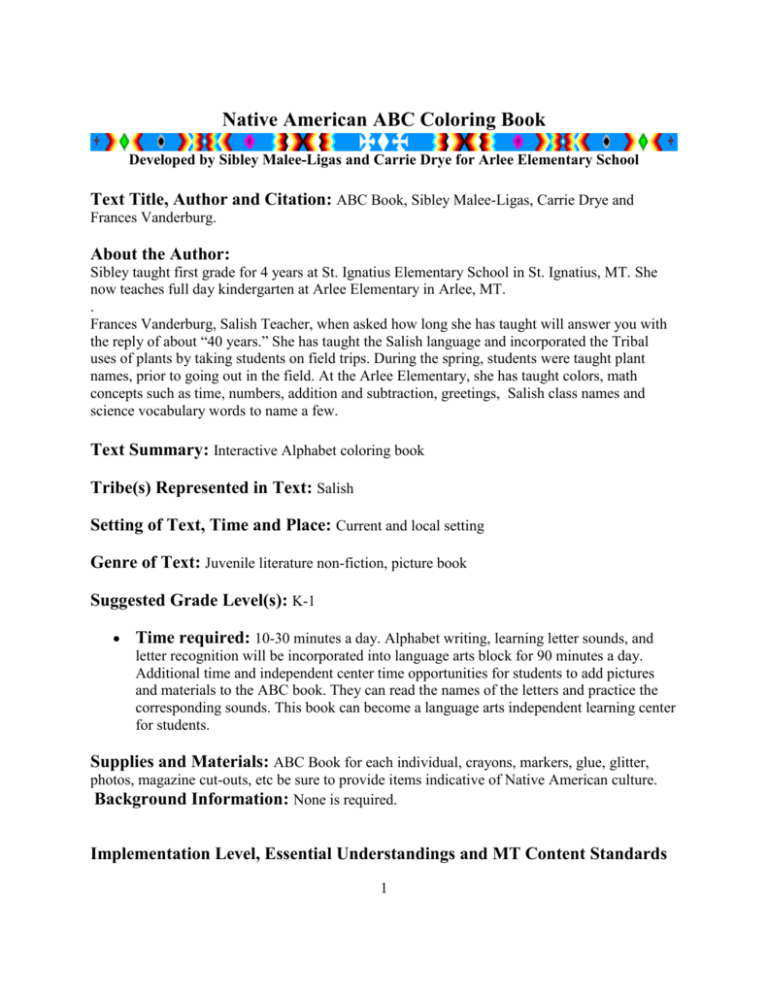
Native American ABC Coloring Book Developed by Sibley Malee-Ligas and Carrie Drye for Arlee Elementary School Text Title, Author and Citation: ABC Book, Sibley Malee-Ligas, Carrie Drye and Frances Vanderburg. About the Author: Sibley taught first grade for 4 years at St. Ignatius Elementary School in St. Ignatius, MT. She now teaches full day kindergarten at Arlee Elementary in Arlee, MT. . Frances Vanderburg, Salish Teacher, when asked how long she has taught will answer you with the reply of about “40 years.” She has taught the Salish language and incorporated the Tribal uses of plants by taking students on field trips. During the spring, students were taught plant names, prior to going out in the field. At the Arlee Elementary, she has taught colors, math concepts such as time, numbers, addition and subtraction, greetings, Salish class names and science vocabulary words to name a few. Text Summary: Interactive Alphabet coloring book Tribe(s) Represented in Text: Salish Setting of Text, Time and Place: Current and local setting Genre of Text: Juvenile literature non-fiction, picture book Suggested Grade Level(s): K-1 Time required: 10-30 minutes a day. Alphabet writing, learning letter sounds, and letter recognition will be incorporated into language arts block for 90 minutes a day. Additional time and independent center time opportunities for students to add pictures and materials to the ABC book. They can read the names of the letters and practice the corresponding sounds. This book can become a language arts independent learning center for students. Supplies and Materials: ABC Book for each individual, crayons, markers, glue, glitter, photos, magazine cut-outs, etc be sure to provide items indicative of Native American culture. Background Information: None is required. Implementation Level, Essential Understandings and MT Content Standards 1 Banks - O’meter Essential Understandings – Big Ideas 4 Social Action X 1-Diversity between tribal groups is great. 5-History represents subjective experience & perspective. 3 Transformative x 2-Diversity between individuals is great. 6-Federal Indian policies shifted through 7 major periods. 2 Additive 3-Oral histories are valid & predate European contact. 7-Tribes reserved a portion of their land-base through treaties. 1 Contributions 4-Ideologies, traditions, beliefs, & spirituality persist 8-Three forms of sovereignty exist - federal, state, & tribal. Montana Content Standards Reading 1.1, 1.2, 1.3, 1.4, 2.1, 4.4 Social Studies Science Listening/Speaking 1.1, 1.2, 2.1, 2.2, 2.3, 3.2, 4.3 Instructional Outcomes – Learning Targets Content Area Standards Essential Understandings 1. There is great diversity among the 12 tribal nations of Montana in their languages, cultures, histories and governments. Each Nation ahs a distinct and unique cultural heritage that contributes to modern Montana. 2. There is great diversity among individual American Indians as identity is developed, defined, and redefined by many entities, organizations and people. There is a continuum of Indian identity ranging from assimilated to traditional and is unique to each individual. There is no genetic American Indian. Social Studies Science Skill Sets Reading 1.1: make predictions and connections between new material and previous information/experiences. 1.2: incorporate new print/non print information into existing knowledge to draw conclusions and make application. 1.3: provide oral, written, and/or artistic responses to ideas and feelings generated by the reading material. 1.4: demonstrate basic understanding of main ideas and some supporting details. 2.1: decode unknown words combing the elements of phonics, grammatical structures, analysis of word parts, and context to understanding reading material. 4.4: read and provide oral, written, and/or artistic responses to diverse perspectives, cultures, and issues in traditional and contemporary literature. 2 Writing 2.5: share/publish a legible final product. Listening/Speaking 1.1: recognize the important role of speaking and listening in daily life. 1.2: identify oneself in various roles in the communication process and recognize the shared communication responsibilities of the speaker and the listener. 2.1: recognize the techniques of listening in a variety of situations (e.g. focusing attention, reflecting, interpreting, analyzing, responding to messages.) 2.2: demonstrate appropriate speaking and listening behaviors in communicating with peers and others in formal and informal classroom situations. 2.3: speak and listen effectively for a range of purposes (e.g. reading aloud, and listening to oral reading, sharing and listening to personal experiences, presenting and listening to oral reports, clearly giving and understanding directions and instructions.) 3.2: select and use appropriate verbal language to convey intended meaning. 4.3: show respect for the feelings and values of others when speaking and listening. Technology Arts: 6.2: create original work using various technologies. Others Learning Experiences – Text-Based Inquiry I have put together two versions of the ABC book. One is labeled the Teacher Manual. It gives ideas of what to include in the ABC book. This manual should represent your local community. The version I have encolsed represents the Arlee Community. The second ABC book is the student version. It is blank. Before: Discuss with students what an alphabet book is about. Ask students if any of them know how to say or sing their ABC’s. Take the time to share a few rounds of singing the song whole group. Then read several published ABC books from your local library or classroom. Introduce the Student ABC book by saying…”today I am going to show you an ABC book about where you live and the things around you every day.” As I read through the book, you may raise your hand to give comments. You will be reading and sharing your version of the ABC book. You may choose to use the icons that we created here or edit the book to make it fit your classroom. Your version will have to be done ahead of time. Take the time to reflect about the diverse community culture in which you live. Content of the ABC book should be relevant to what you are teaching. What resources are you going to be able to access that accurately represent your class? 3 During: As you read the book, pause at each page to let students enjoy your pictures and drawings. Have them make comments and connections to print. After: Each student will receive their own copy of the ABC book. This book is blank. They may choose to draw pictures, glue pictures from magazines, attach photographs, or use other materials. At the beginning, I am looking for things that begin with the initial consonant/vowel sounds. Assessment: Teacher observation and student product of ABC book. Teacher Notes and Cautions: If you do not know please ask! Go to Tribal web sites, community resources, or OPI. Create your own ABC book that represents your class and local community in which you live and learn and the ways in which you are going to have your students learn about the Native American People of Montana. Students will contribute their ideas into your final teacher manual. This book will continue to be a work in progress. The student books take time to create. My students worked on them the entire first quarter of school. During the school year 2006-07, my Kindergarten class created a floor size ABC quilt along with the high school Family and Consumer Science students. I am indebted to Joyce Auer, their teacher, for her help in putting an ABC quilt together. We illustrated blocks for each letter that represented us as a class. It quickly became a favorite independent learning center. Vocabulary: Any items students choose to place or draw into their ABC coloring book. Extension Activities: ABC Class books. ABC Classroom quilt ABC Freeze Tag ABC Art ABC Line-up using initial letter of first names. Resources and References: Montana OPI web site www.montanatribes.org Arlee’s Ready to Go grant; Carrie Drye’s unit on culturally relevant language arts A Mountain Alphabet by Andrew Kiss and Margriet Ruurs, Published by Tundra Books of Northern New York, Plattsburgh, N.Y. 12901, 1996. Cyndy Szekeres’ ABC, A Golden Book, New York, Western Publishing Company, Inc., Racine, Wisconsin 53404, 1983. The Icky Bug Alphabet Book by Jerry Pallotta, Illustrated by Ralph Masiello, Published by Charlesbridge Publishing, 85 Main Street, Watertown, MA 02472, 1986. 4 M is for Montana by Gayle Corbett Shirley, Illustrated by Constance Rummel Bergum, Published by Falcon Press, Co., Inc., Helena, MT, 1992. Many Nations, An Alphabet of Native America by Joseph Bruchac, Illustrated by Robert F. Goetzl, Published by BridgeWater Paperback, 1998. A Northwest ABC Coloring Book by Cindy Gilman for the Northwest Native American Reading Curriculum, In collaboration with the Evergreen State College and the Office of Public Instruction, Funded by Higher Education Coordinating Board of Washington, Olympia, WA, 2002. Flathead Nation Salish Dictionary, by Tachini Pete, Published by Bilingual Education Department, Salish Kootenai College, Pablo, MT 5


